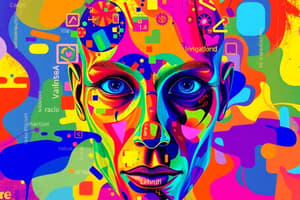Podcast
Questions and Answers
Which of the following features can be detected by the Face Service in Azure AI Vision?
Which of the following features can be detected by the Face Service in Azure AI Vision?
- Facial similarity matching
- Blurred edges (correct)
- Identity verification
- Handwritten text
What capability is NOT accessible to non-Managed Microsoft customers using the Face Service?
What capability is NOT accessible to non-Managed Microsoft customers using the Face Service?
- Exposure assessment
- Blur detection
- Head pose analysis
- Similarity matching (correct)
What is the main purpose of flattening feature maps in a neural network?
What is the main purpose of flattening feature maps in a neural network?
- To prepare feature values for a fully connected layer (correct)
- To reduce the complexity of the neural network
- To enhance the interpretability of visual features
- To increase the dimensionality of input data
Which analysis technique would you use to extract printed text from an image?
Which analysis technique would you use to extract printed text from an image?
During the training of a convolutional neural network, how are the filter kernels initialized?
During the training of a convolutional neural network, how are the filter kernels initialized?
What kind of analysis does Azure's Optical Character Recognition service perform?
What kind of analysis does Azure's Optical Character Recognition service perform?
What is a key feature of multi-modal models?
What is a key feature of multi-modal models?
Which two features can the Face Service analyze regarding facial characteristics?
Which two features can the Face Service analyze regarding facial characteristics?
Which of the following capabilities is NOT commonly associated with image analysis in Azure?
Which of the following capabilities is NOT commonly associated with image analysis in Azure?
What type of image analysis does the Face Service focus on?
What type of image analysis does the Face Service focus on?
Which capability allows for the asynchronous analysis of larger documents?
Which capability allows for the asynchronous analysis of larger documents?
What does Optical Character Recognition (OCR) primarily achieve in image analysis?
What does Optical Character Recognition (OCR) primarily achieve in image analysis?
Which technique is used for recognizing and verifying individual faces in image data?
Which technique is used for recognizing and verifying individual faces in image data?
Which aspect of an image can Azure's Face Service NOT analyze?
Which aspect of an image can Azure's Face Service NOT analyze?
What distinguishes Managed Microsoft customers in their usage of the Face Service?
What distinguishes Managed Microsoft customers in their usage of the Face Service?
How do fully connected neural networks process feature values from previous layers?
How do fully connected neural networks process feature values from previous layers?
Which of the following is a primary function of Optical Character Recognition (OCR) in Azure's AI Vision?
Which of the following is a primary function of Optical Character Recognition (OCR) in Azure's AI Vision?
What type of analysis allows for detecting specific items and attributes within an image?
What type of analysis allows for detecting specific items and attributes within an image?
What is the effect of iteratively adjusting weights in a trained neural model?
What is the effect of iteratively adjusting weights in a trained neural model?
Which of the following capabilities is integral to the functionality of computer vision services on Azure?
Which of the following capabilities is integral to the functionality of computer vision services on Azure?
What is the primary function of filters in image processing?
What is the primary function of filters in image processing?
Which service is included in Azure AI Vision for identifying faces in images?
Which service is included in Azure AI Vision for identifying faces in images?
What are convolutional neural networks primarily used for in computer vision?
What are convolutional neural networks primarily used for in computer vision?
Which of the following techniques is primarily used to analyze the content of images?
Which of the following techniques is primarily used to analyze the content of images?
What is the main goal of image captioning technologies?
What is the main goal of image captioning technologies?
Which component of convolutional neural networks extracts feature maps?
Which component of convolutional neural networks extracts feature maps?
Which of the following best describes optical character recognition?
Which of the following best describes optical character recognition?
What role does labeled data play in training convolutional neural networks?
What role does labeled data play in training convolutional neural networks?
What is the fundamental purpose of object detection in computer vision?
What is the fundamental purpose of object detection in computer vision?
Which technique is used to separate different elements within an image for analysis?
Which technique is used to separate different elements within an image for analysis?
Flashcards
Computer Vision
Computer Vision
A field of artificial intelligence focused on enabling computers to interpret and understand images and videos.
Pixel Values
Pixel Values
Individual numerical values that represent color and intensity of a point within an image.
Image Processing
Image Processing
Manipulation of digital images using algorithms to modify or enhance them.
Filters
Filters
Signup and view all the flashcards
Convolutional Neural Networks
Convolutional Neural Networks
Signup and view all the flashcards
Feature Maps
Feature Maps
Signup and view all the flashcards
Labeled Images
Labeled Images
Signup and view all the flashcards
Feature maps
Feature maps
Signup and view all the flashcards
Flattened feature maps
Flattened feature maps
Signup and view all the flashcards
Fully connected neural network
Fully connected neural network
Signup and view all the flashcards
Output layer
Output layer
Signup and view all the flashcards
Probability value
Probability value
Signup and view all the flashcards
Filter kernels
Filter kernels
Signup and view all the flashcards
Random weights
Random weights
Signup and view all the flashcards
Image analysis
Image analysis
Signup and view all the flashcards
Image tagging
Image tagging
Signup and view all the flashcards
Image captions
Image captions
Signup and view all the flashcards
Model customization
Model customization
Signup and view all the flashcards
Optical Character Recognition (OCR)
Optical Character Recognition (OCR)
Signup and view all the flashcards
Face detection
Face detection
Signup and view all the flashcards
Face recognition
Face recognition
Signup and view all the flashcards
Multi-modal models
Multi-modal models
Signup and view all the flashcards
Semantic relationships
Semantic relationships
Signup and view all the flashcards
Azure AI Vision service
Azure AI Vision service
Signup and view all the flashcards
Face detection
Face detection
Signup and view all the flashcards
Blur Detection
Blur Detection
Signup and view all the flashcards
Exposure Detection
Exposure Detection
Signup and view all the flashcards
Glasses Detection
Glasses Detection
Signup and view all the flashcards
Head Pose Detection
Head Pose Detection
Signup and view all the flashcards
Noise Detection
Noise Detection
Signup and view all the flashcards
Occlusion Detection
Occlusion Detection
Signup and view all the flashcards
Similarity matching
Similarity matching
Signup and view all the flashcards
Identity verification
Identity verification
Signup and view all the flashcards
Optical Character Recognition (OCR)
Optical Character Recognition (OCR)
Signup and view all the flashcards
Study Notes
Microsoft Azure AI Fundamentals: Computer Vision
- This presentation covers Microsoft Azure AI Vision Fundamentals
- The agenda includes computer vision concepts and computer vision capabilities in Azure
- Learning objectives include understanding Azure AI Vision capabilities, identifying Azure AI Vision services, and describing the Face detection service
Agenda
- Computer vision concepts are a key topic
- Computer vision capabilities in Azure are also discussed
Learning Objectives
- Understand the capabilities of Azure AI Vision
- Identify different services included in Azure AI Vision
- Describe the Face detection service
Computer Vision Concepts
- Images are represented as arrays of pixel values
Images and Image Processing
- Filters are applied to modify images based on pixel values
Convolutional Neural Networks (CNNs)
- Labeled images are used to train the model
- Filter layers extract features from each image
- Feature maps are flattened
- Feature values are processed by a fully connected neural network
- The output layer predicts probabilities for different classes
Multi-modal Models
- Combines language and vision models to encode image and text data
- Models encapsulate semantic relationships between extracted features
- Multi-modal models can be used as foundational models for specialized adaptive models
Computer Vision Services in Azure
- Vision service encompasses Image Analysis (image tagging, captions, customization, OCR, spatial analysis)
- Face service encompasses Face detection and Face recognition
Image Analysis 4.0 with AI Vision Service
- Capabilities include model customization, reading text from images, detecting people, generating image captions, detecting objects, tagging visual features, and smart cropping
Exercise: Analyze Images in Vision Studio
- Use the hosted environment and Azure credentials provided.
- Instructions are available through a link on Learn
Detecting Faces with the Face Service
- The Face service detects faces and identifies attributes like blur, exposure, glasses, head pose, noise, occlusion
- Managed customers can access facial recognition capabilities, including similarity matching and identity verification
Demo: Detect Faces in Vision Studio
- The demo shows face detection capabilities of the Azure AI Face service
Reading Text with Optical Character Recognition (OCR)
- Detects locations and characters of printed and handwritten text
- Options for quick text extraction from images or asynchronous analysis of larger scanned documents
Demo: Read Text in Vision Studio
- This demo demonstrates Azure AI Vision optical character recognition capabilities
Knowledge Check
- Question 1: The Face detection service cannot identify faces that are obscured.
- Question 2: A dedicated Azure AI service is suitable for accessing multiple Azure services using a single key.
- Question 3: Azure AI Vision services include Face detection, Optical Character Recognition, and Document Intelligence.
Studying That Suits You
Use AI to generate personalized quizzes and flashcards to suit your learning preferences.



